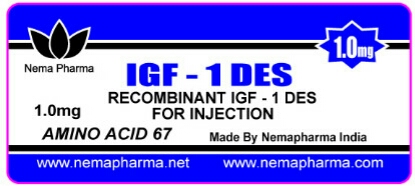
IGF-1 des 1.0 mg
Evolutionary.org
Join Evolutionary Forums
PEPTIDE PROFILES KBKB 3 years ago No Comments 30,450 views 17 likes
Insulin-like growth factor-1 (IGF-1)
IGF-1 (Insulin-like growth factor) is an endocrine hormone that is produced in the liver. The production of IGF-1 is increased in the presence of growth hormone. There are many different types of cells in the body that are equipped with a receptor to accept IGF-1. This makes IGF-1 a good protagonist at targeting tissues to spur cell to cell communication (growth) or in a more autocrine cell signaling process that facilitates cell division.
Why is this IGF-1 important for a bodybuilder or athlete? Let�s take a look at the list:
Helps regulate fat for use as energy, resulting in fat loss.
Contributes to anti aging. As we get older, IGF-1 production slows down and this results in cell reduction. Low levels of IGF-1 are linked to heart failure, lower brain cell regulation and neuron function. Not to mention muscle tissue breakdown.
Helps to increase nutrient shuttling (protein synthesis).
Increases regenerative functions of nerve tissues.
Boosts the ability to cause hyperplasia in muscle cells resulting in fuller muscle tissue.
igf-1 chemical structure
Fig 1. IGF-1 Chemical Structure
Why use IGF-1?
To put it simply, the gains from IGF-1 (all variants) are not due to water weight, so the gains you will achieve will be long term muscle growth. This is compared to steroids, which are renowned for putting on water weight and giving you nasty side effects. You are not going to gain 10lbs from using IGF-1, but you will see solid 1-2lbs gains every 1-2 weeks.
The most important factor to consider is IGF-1�s ability to achieve hyperplasia. When you use steroids, they will help the body through hypertrophy, which means you are increasing the size of the existing muscle cells. On the other hand, IGF-1 will cause hyperplasia, which means you are actually increasing the number of cells in the muscle tissue. These new cells can be utilized through further training, and use of steroids, to make bigger muscles. Essentially, you will have the ability to achieve more muscle density and size at the genetic level by using IGF-1.
Variants
IGF-1 variants are split into two groups: IGF-1 LR3 and DES IGF-1 (usually presented as IGF-1 DES). Base IGF-1 has a very short half life (about 10-20 minutes); as a result, it is quickly destroyed by the body. This is why IGF-1 was modified to make the amino acid analog IGF-1 LR3 (Long). The other variant of IGF-1 called DES IGF-1 is a truncated version that is 10X more potent than IGF-1. Both variants are similar to its root but have different actions, allowing them to function in a specific ways.
IGF-1 LR3
IGF-1 LR3 has a half-life of about 20-30 hours and is much more potent than base IGF-1. Since its half-life is about a day, the IGF-1 LR3 will circulate the body, for around 24 hours, binding to receptors and activating cell communication that improves muscle growth and fat loss.
LR3 prevents glucose from entering into cells, which, in turn, forces the body to burn fat and not sucrose. In addition, its long half-life is desirable for another reason; site injections aren't necessary, as IGF-1 LR3 will cycle the body binding to all muscle cells for about a day.
IGF-1 DES
DES IGF-1 is the shorter version of the IGF-1 chain. It is five (5) times more powerful than IGF-LR3 and ten (10) times more powerful than regular base IGF-1. The half-life for DES is about 20-30 minutes, which means this is a very delicate chain. Therefore, administration should only be done at the site where you want to see muscle growth. DES has the ability to stimulate muscle hyperplasia better than LR3. In simple terms, it's best used for site injections, rather than overall growth.
In addition, DES is known to bind to receptors that have been deformed by lactic acid, which is often present during workouts. This allows the DES to attach itself to a mutated receptor and signal tissue growth during training. DES can be used longer and more frequently than LR3.
All Copy Rights Recived By Nemapharma.com.